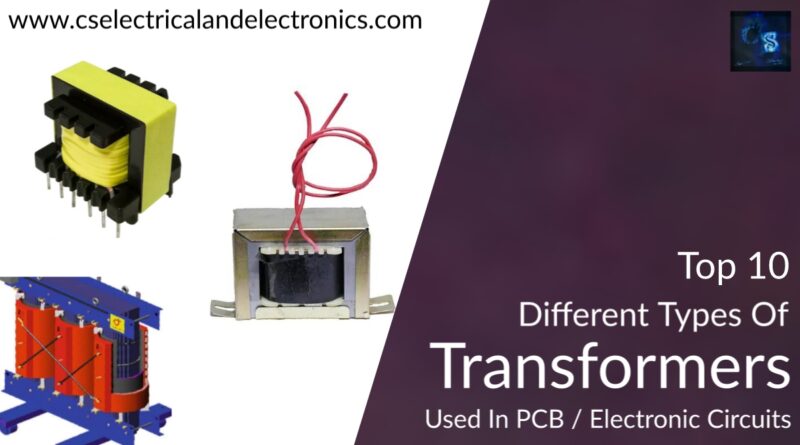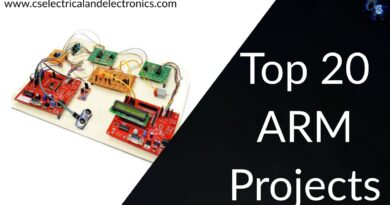Top 10 Different Types Of Transformers Used In PCB / Electronic Circuits
Hello guys, welcome back to my blog. This article will be on the top 10 different types of transformers used in PCB or electronic circuits, we will share the function of each transformer or why it is used.
If you have any electrical, electronics, and computer science doubts, then ask questions. You can also catch me on Instagram – CS Electrical & Electronics And Chetan Shidling.
Also, read:
- Different Types Of Lithium-Ion Batteries, Working, Applications
- Top 12 Longest Transmission Lines In The World In 2022 Must Know
- Top 14 Types Of Relay In Power Systems, Working, Purpose
Different Types Of Transformers
Transformers are classified into various types such as:
01. Laminated core Power Transformer
This is the most popular type of transformer, which is used to convert mains voltage to low voltage to power electronic devices in electric power transmission and appliances. They come in a variety of power levels, from mW to MW. Eddy’s current losses in the iron core are reduced thanks to the insulated laminations.
A split bobbin can be used in small appliances and electronic transformers to provide a high level of insulation between the windings. Stampings are used to make the rectangular cores, which are usually in E-I form pairs, although other shapes are occasionally utilized. To decrease EMI (electromagnetic interference), shields between the primary and secondary can be installed, or a screen winding can be employed on occasion.
A thermal cut-out integrated into the winding of small appliances and electronics transformers may shut off power at high temperatures to prevent additional overheating.
02. Autotransformer
An autotransformer is made up of only one winding that is tapped at some time. A larger (or lower) voltage is created across another area of the same winding when voltage is delivered across one terminal. The autotransformer’s equivalent power rating is lower than the actual load power rating.
An autotransformer is cheaper, lighter, smaller, and more efficient than an isolating (two-winding) transformer of the same rating for voltage ratios less than roughly 3:1. In electric power distribution systems, large three-phase autotransformers are used to connect 220 kV and 33 kV sub-transmission networks, as well as other high voltage levels.
03. Grounding transformer
Grounding or earthing transformers allow three-wire (delta) polyphase system supply adapt phase to neutral loads by providing a return channel for current to a neutral. Grounding transformers are often made up of a single winding transformer with a zigzag winding design, but they can also include a wye-delta isolated winding transformer connection.
04. Phase-shifting transformer
This is a customized transformer that may be set up to change the phase connection between the input and output. This permits management of power flow in an electric grid, such as steering power flows away from a shorter (but overcrowded) route and onto a longer channel with surplus capacity.
05. Cast resin transformer
The windings of cast-resin power transformers are encased in epoxy resin. Because these transformers are dry and do not require cooling oil, they are easy to install indoors and do not require a fire-proof vault. The epoxy seals the windings against dust and corrosive environments. The design of the transformers is less flexible since the molds for casting the coils are only available in predetermined sizes, which may make them more expensive if specific characteristics (voltage, turns ratio, taps) are required.
06. Current transformer
A current transformer (CT) is a series-connected measuring device that provides a secondary coil current proportionate to the original coil current. In the electrical power business, current transformers are extensively employed in metering and protective relays. A single main turn (either an insulated cable or an uninsulated bus bar) is typically passed through a well-insulated toroidal core wrapped with numerous turns of wire to make current transformers. The current ratio from primary to secondary is a common way to characterize the CT.
07. Voltage transformer or potential transformer
Voltage transformers (VT), sometimes known as potential transformers (PT), are a type of parallel-connected instrument transformer used for high-voltage circuit metering and protection, as well as phasor phase shift isolation. They’re made to put very little demand on the supply being tested and to have a precise voltage ratio so that accurate metering may be done. On the same core as the primary winding, a potential transformer may include numerous secondary windings for use in various metering or protective circuits. The primary might be phase to ground or phase to phase linked. On one terminal, the secondary is normally grounded.
08. Pulse transformer
A pulse transformer is an electrical transformer designed to transport rectangular electrical pulses (that is, pulses with fast rise and fall times and a relatively constant amplitude). In digital logic and telecommunications circuits, such as Ethernet, small versions known as signal types are frequently employed to match logic drivers to transmission lines. Ethernet transformer modules are another name for them.
09. Audio transformer
Audio transformers are transformers that are particularly built to handle audio signals in audio circuits. They can be used to block radio frequency interference or the DC component of an audio signal, split or merge audio signals, or provide impedance matching respectively high and low impedance circuits, such as between a high impedance tube (valve) amplifier output or a low impedance loudspeaker, or between a high impedance instrument output and just a mixing console’s low impedance input. Audio transformers for loudspeaker voltages and currents are greater than those for microphone or line level, which carry significantly less power. Bridge transformers bridge the gap between two-wire and four-wire communication networks.
10. Flyback
Flyback transformers are high-voltage, high-frequency transformers that are utilized in plasma balls and cathode-ray tubes (CRTs). It delivers the high anode DC voltage (typically several kV) necessary for CRT functioning. The picture displayed by the CRT can be distorted due to variations in the anode voltage supplied by the flyback. Multiple secondary windings may be present in CRT flybacks to give a variety of lower voltages. Because it is frequently used with a voltage multiplier, which may be integrated with the flyback, its output is frequently pulsed.
To summarise, There are several transformer types utilized in the electrical power system for various reasons, such as power generation, distribution, transmission, and power consumption. Voltage levels, core media employed, winding.
This was about “Different Types Of Transformers“. I hope this article “Different Types Of Transformers” may help you all a lot. Thank you for reading.
Also, read:
- 10 Tips To Maintain Battery For Long Life, Battery Maintainance
- 10 Tips To Save Electricity Bills, Save Money By Saving Electricity
- 100 (AI) Artificial Intelligence Applications In The Automotive Industry
- 100 + Electrical Engineering Projects For Students, Engineers
- 1000+ Control System Quiz, Top MCQ On Control System
- 1000+ Electrical Machines Quiz, Top MCQs On Electrical Machines
- 1000+ MATLAB Simulink Projects For MTech, Engineering Students
- 50 Tips To Save Electricity At Home, Shop, Industry, Office
Author Profile
- Chetu
- Interest's ~ Engineering | Entrepreneurship | Politics | History | Travelling | Content Writing | Technology | Cooking
Latest entries
 All PostsApril 29, 2024Top 11 Free Courses On Battery For Engineers With Documents
All PostsApril 29, 2024Top 11 Free Courses On Battery For Engineers With Documents All PostsApril 19, 2024What Is Vector CANoe Tool, Why It Is Used In The Automotive Industry
All PostsApril 19, 2024What Is Vector CANoe Tool, Why It Is Used In The Automotive Industry All PostsApril 13, 2024What Is TCM, Transmission Control Module, Working, Purpose,
All PostsApril 13, 2024What Is TCM, Transmission Control Module, Working, Purpose, All PostsApril 12, 2024Top 100 HiL hardware in loop Interview Questions With Answers For Engineers
All PostsApril 12, 2024Top 100 HiL hardware in loop Interview Questions With Answers For Engineers








